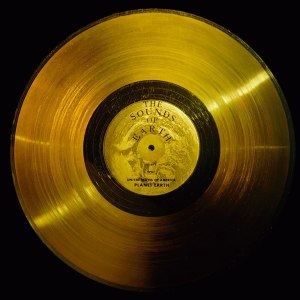Whatever happened with that news last year about finding life on Venus? Something about phosphine, whatever that is.
And what about the cigar-shaped space rock with the unusual name (Oumuamua) they found in 2017 and called an “interstellar visitor”? Aliens, right? Where’s the follow-up on that?
The shortest, simplest answer to both these versions of the Big Question is that scientists are working on it.
Their scientific method is a very useful tool for getting to the root of things, but it takes time. Too, jargon and the technical details involved do not make for reader-friendly stories.
That’s why journalists usually wait for results to be announced in simple language.
Many years can pass in between press conferences. And sometimes other research teams come up with different results in the meantime, which the journalists also must report.

“…the launching of this ‘bottle’ into the cosmic ‘ocean’ says something very hopeful about life on this planet.” — Carl Sagan via Wikipedia.
This extended, open-ended process generally leaves us laypeople feeling confused and a little put off by Science — except when the topic is “Life Out There.”
THAT always gets our attention.
It appeals to our gut feeling that, if humanity keeps searching long enough, we’ll find ET someday, looking back at us and glad to discover that it’s not alone in this huge universe.
Is that a valid hope or are we just projecting our social selves onto the cosmos?
Alien life isn’t impossible
I’ve found out something cool while reading through the sources for this chapter of the series on how cats evolved.
Painstaking efforts by the world’s top brains have not yet completely ruled out the possibility that there could be extraterrestrial life somewhere.
While probably unintelligent from our viewpoint (NASA, 2021d)), it might be able to hitch a ride through the galaxy to reach our neighborhood!
Of course, boffins haven’t confirmed this.
And whether ET, if it exists, has gotten here is a whole other question.
But such a journey is at least astrophysically possible when rock shields the hypothetical little space tourist from deadly UV radiation and cosmic rays. (Wesson)
I know: Oumuamua, right?

A meteorite found in Algeria. (Image: H. Raab via Wikimedia
Well, probably not. Wesson was writing seven years before that was discovered.
He also described the organism’s protection as a fairly thin rocky layer — the surface of a meteorite, for instance — not something that might be almost as big as the International Space Station (but not shaped like the ISS).
We’ll get to the arguments scientific debate over Oumuamua later on.

Pick-up or delivery? (Image: BolshieBufera/Shutterstock)
For now, let’s just ponder the delightful possibility that a common ancestor of cats and all other life on Earth really might have arrived from space very early in our planet’s history. (Walker et al., 2017b; Wesson)
This isn’t sensationalism: some of the best minds on the planet are discussing it (although they focus on chemistry, physics, and microbiology processes, not cats).
You see, they’re stuck with a couple of major problems that finding ET might help them handle:
- There is a mysterious gap in Earth’s fossil record.
Using a little ingenuity (including “molecular fossils” described in the last chapter), paleontologists have traced Life back slightly more than 3.5 billion years to the Last Universal Common Ancestor (LUCA), whatever that might have been (no one knows for sure, but it definitely existed, perhaps along with other acronym-labeled entities if you subscribe to the hypothesis, which is too complex to get into here, that viruses were also involved).
Then the rocky archives go blank during the most important part of terrestrial history: Life’s first appearance after young planet Earth had cooled down enough to support it.
That wouldn’t matter as much if scientists already knew the universal laws on how to turn a lump of matter into Life. (Walker et al., 2017b)
After all, if you understand how gravity works, you don’t need NASA and the Avengers’ secret test facility (yes) to predict what will happen when you drop a heavy object and a feather in a vacuum):
But scientists don’t know those universal laws of starting Life yet, because of the next problem.
- Astrobiologists have only one sample of life to work with: our own biosphere. (Walker et al., 2017b)
If they can get one or more additional samples — that is, if Life is found either in the Solar System or on any of the 4,000-plus known exoplanets (those orbiting other stars) — they might then be able to fill in the blank in Earth’s Precambrian archives, or at least to get a better understanding about what might have occurred back then.
So we are looking outwards not only to find ET but also in search of clues to the roots of terrestrial Life here at home.
Read the whole thing
Featured image: Andrey_F/Shutterstock
